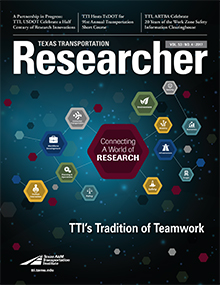When we think of a roadway, most of us think of the asphalt or concrete we’re riding on, not the ditches lining the roads or how efficiently water flows off those roads following a rainstorm. The Texas A&M Transportation Institute (TTI) has come up with an automated way of determining whether those ditches are doing their job properly and safely.

The Texas Department of Transportation (TxDOT) maintains an extensive data repository documenting the performance of roadways in the state. Charles Gurganus, associate research engineer in TTI’s Pavements and Materials Division, is studying an automated method of providing TxDOT with right-of-way-line to right-of-way-line roadway surface geometric information. The project is called Developing a Surface Drainage Rating for Inclusion in TxDOT’s Asset Management System.
Using light detection and ranging (LIDAR) technology, Gurganus can collect extensive roadway geometric data, including roadway cross slopes, super elevations, front slope steepness and drainage areas. The technology can also determine the depth of a roadside ditch and its offset related to the nearby pavement structure. All data can be collected at highway speeds.
“It’s almost like we are proving what has always been intuitive about roadway work,” says Gurganus. “We think shallow ditches close to the edge of the pavement may cause pavement problems. We think deeper ditches farther away from the pavement edge with a good longitudinal grade are more desirable. Now we can measure that at a network level and compare it to pavement performance.”
The technology is a single, boom-mounted laser device raised 10 feet in the air. It also uses GPS, an inertial measurement unit and a video camera.
Gurganus hopes to link road distress problems to the collected data. “We know this roadway is having performance problems from a distress standpoint,” he says. “How does that relate to ditch depth and offset? If a roadway is performing poorly — such as indicated by alligator cracking or rutting — we can now show that it has a shallow ditch close to the pavement’s edge. If repairs are going to be made, we can deepen the ditch and move it away from the pavement. It’s a more holistic repair approach.”
Data have been collected from roadways in TxDOT’s Austin, Brownwood, Bryan, Atlanta, Tyler and Corpus Christi Districts. The challenge is taking that data and deriving useful information from them. In 12 miles of roadway, the system can generate 25 million data points, and that’s a lot to parse and analyze. As Gurganus notes, “The challenge is how to go from being data rich to being information rich. How do we supply the client with information-rich data that meets their needs?”
The ultimate goal is to enable integration of the information generated by Gurganus’s collection method into TxDOT’s project development process. Doing so can help the department better refine its project scopes before implementation.
“This should help TxDOT stretch its funds farther and do more lane miles of work every year,” Gurganus says. “Maintenance supervisors will be able to focus on problem spots with measurable data. Time, effort, materials and money will impact roads that really need it.”
“This project has shown us that mobile LIDAR can be an effective tool to capture geometric features from right-of-way line to right-of-way line that can better inform our decision makers and improve how we manage the network,” says Magdy Y. Mikhail, section director of pavement asset management in TxDOT’s Maintenance Division.

